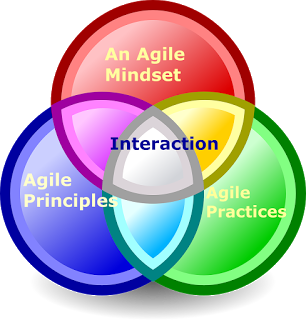“Digital Agility - The Rocky Road from Doing Agile to Being Agile” Book Introduction Chapter 3 Agile Best and Next Practices
 Although Agile has been adopted by mainstream and has been proven with advantage for better improvement and speed, how does a group or a company move from a typical waterfall environment to agile methodologies? And even more importantly, how to follow the set of agile principles and practice Agile up, to build an agile leadership team or boardroom, and practice agile philosophy to run an entire organization?
Although Agile has been adopted by mainstream and has been proven with advantage for better improvement and speed, how does a group or a company move from a typical waterfall environment to agile methodologies? And even more importantly, how to follow the set of agile principles and practice Agile up, to build an agile leadership team or boardroom, and practice agile philosophy to run an entire organization?
Select the right fit pilot project to experiment, learn, and improve: It is important to select the right fit pilot project to see how it worked to avoid those who are resistant to changing digging in their heels. Build a transition team with the right talent, it takes training, patience, and guidance. Everybody views change in a different way moving from waterfall to agile is a very good change. Clearly identify items that needed to be changed, modified, or fixed, to truly be Agile take a step-wise approach. Go back to the agile manifesto, particularly,”While there is value in the items on the right, we value the items on the left more.” It means doing what is required and stay focused on the end product.
Self-organizing and self-managing: Forward-thinking organizations today are on the journey of digital transformation, what’s the optimal digital management style? There is a whole spectrum between minimally self-organizing and fully self-managing. Self-organizing is about empowerment and trust. You know the team will deliver the best outcome, and give them the freedom to do it on their way. The team is self-organizing in being disciplined enough to do the work. A team can be self-organizing in determining the best and most efficient method of delivering the commitments they had made, and the business should also expect professionalism from the team. A self-organizing team, thus, has full authority on the practices, processes, tools, engineering methodologies team members would like to use to build the products.
 Engineering practices are the core: One of the biggest argument about Agile is about DISCIPLINE, Agile is not lack of discipline, but takes more discipline. You achieve the ability to be agile in product development by following engineering practices that allow you to adapt as efficiently as possible. The benefits of agility are not sustainable unless engineering practices are adopted in the earnest. While agile principles are essentially about people, it doesn’t mean that engineering problems can be ignored. As one of the Agile principles clarified: “continuous attention to technical excellence and good design enhances agility.”
Engineering practices are the core: One of the biggest argument about Agile is about DISCIPLINE, Agile is not lack of discipline, but takes more discipline. You achieve the ability to be agile in product development by following engineering practices that allow you to adapt as efficiently as possible. The benefits of agility are not sustainable unless engineering practices are adopted in the earnest. While agile principles are essentially about people, it doesn’t mean that engineering problems can be ignored. As one of the Agile principles clarified: “continuous attention to technical excellence and good design enhances agility.”There is no “one size fits all” agile approach. However, it is important to develop a set of best and next practices to scale up and improve agile maturity. Agile could be seen as the social practice of complexity theory, and as such, there are two aspects of the same reality and contributions on two complementary levels of dealing with the same issues: respond to customer requests quickly and make sure problems are really resolved. And Agile practices up mean more about a mind shift and a set of principles to run an agile organization. Follow us at: @Pearl_Zhu
Published on June 15, 2016 23:31
No comments have been added yet.



